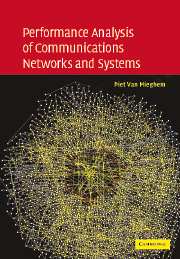Book contents
- Frontmatter
- Contents
- Preface
- 1 Introduction
- Part I Probability theory
- Part II Stochastic processes
- Part III Physics of networks
- 15 General characteristics of graphs
- 16 The Shortest Path Problem
- 17 The effciency of multicast
- 18 The hopcount to an anycast group
- Appendix A Stochastic matrices
- Appendix B Algebraic graph theory
- Appendix C Solutions of problems
- Bibliography
- Index
16 - The Shortest Path Problem
from Part III - Physics of networks
Published online by Cambridge University Press: 22 February 2010
- Frontmatter
- Contents
- Preface
- 1 Introduction
- Part I Probability theory
- Part II Stochastic processes
- Part III Physics of networks
- 15 General characteristics of graphs
- 16 The Shortest Path Problem
- 17 The effciency of multicast
- 18 The hopcount to an anycast group
- Appendix A Stochastic matrices
- Appendix B Algebraic graph theory
- Appendix C Solutions of problems
- Bibliography
- Index
Summary
The shortest path problem asks for the computation of the path from a source to a destination node that minimizes the sum of the positive weights of its constituent links. The related shortest path tree (SPT) is the union of the shortest paths from a source node to a set of m other nodes in the graph with N nodes. If m = N − 1, the SPT connects all nodes and is termed a spanning tree. The SPT belongs to the fundamentals of graph theory and has many applications. Moreover, powerful shortest path algorithms like that of Dijkstra exist. Section 15.7 studied the hopcount, the number of hops (links) in the shortest path, in sparse graphs with unit link weights. In this chapter, the influence of the link weight structure on the properties of the SPT will be analyzed. Starting from one of the simplest possible graph models, the complete graph with i.i.d. exponential link weight, the characteristics of the shortest path will be derived and compared to Internet measurements.
The link weights seriously impact the path properties in QoS routing (Kuipers and Van Mieghem, 2003). In addition, from a traffic engineering perspective, an ISP may want to tune the weight of each link such that the resulting shortest paths between a particular set of in- and egresses follow the desirable routes in its network. Thus, apart from the topology of the graph, the link weight structure clearly plays an important role. Often, as in the Internet or other large infrastructures, both the topology and the link weight structure are not accurately known.
- Type
- Chapter
- Information
- Performance Analysis of Communications Networks and Systems , pp. 347 - 386Publisher: Cambridge University PressPrint publication year: 2006
- 1
- Cited by



